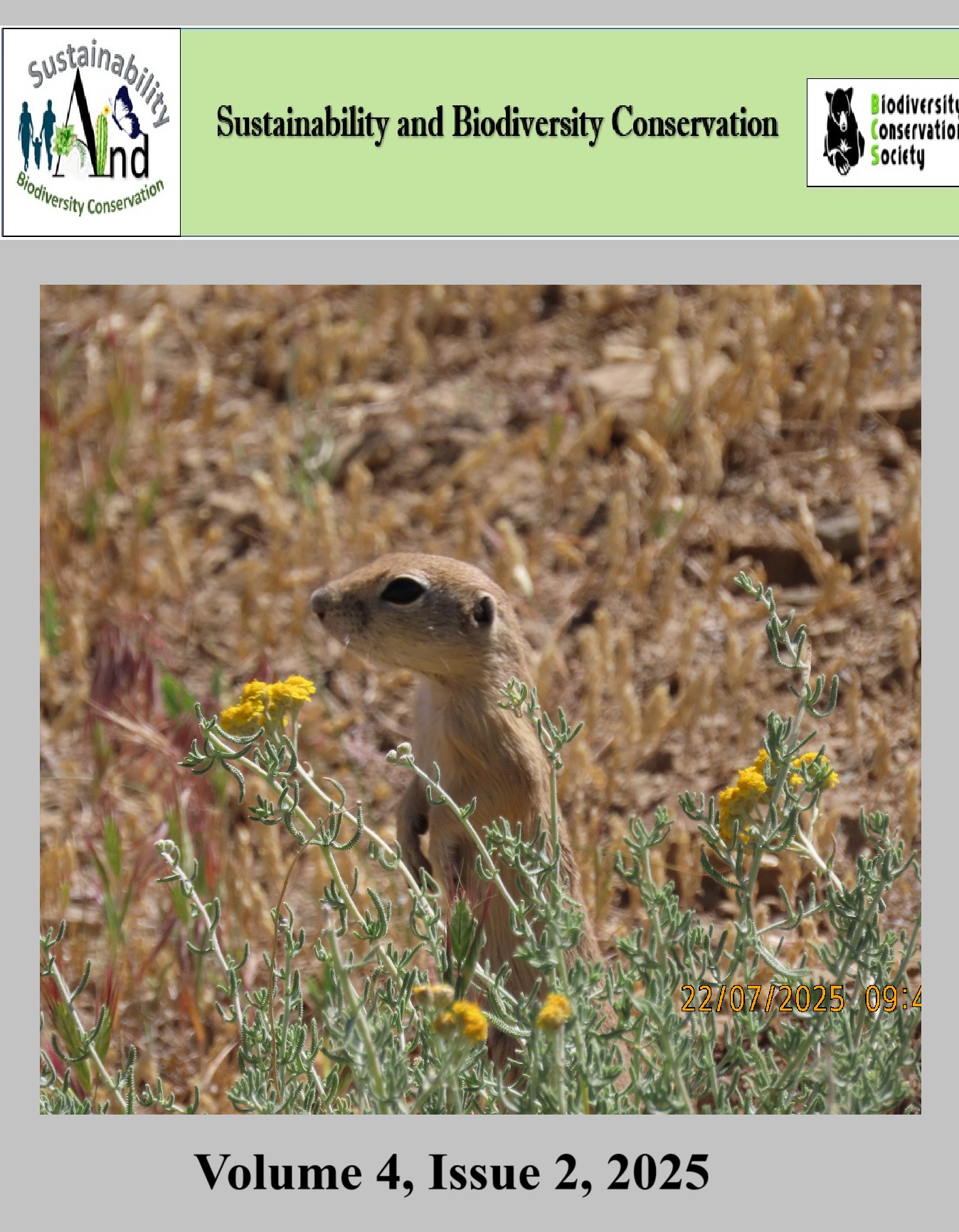Biodiversity Loss Due to Forest Diversion
DOI:
https://doi.org/10.5281/zenodo.15622472Keywords:
Biodiversity loss, forest diversion, fragmentation, non-forestry, habitat lossAbstract
Forests, constituting 31% of Earth's surface, are crucial ecosystems vital for regulating ecosystem functions. Despite their ecological sensitivity and diverse contributions, such as food and water supply, biodiversity habitats, and climate regulation, global forests face escalating threats from industrialisation, urbanisation, and population growth. Development activities like urban expansion, transport, and hydroelectricity generation exacerbate the loss of ecological diversity, resulting in forest disappearance, habitat fragmentation, and altered land use. Forest diversion, involving clearing for agriculture and non-forestry purposes, poses a significant menace, with 80.30% of such diversions concentrated in Telangana, Rajasthan, Madhya Pradesh, Maharashtra, and Odisha. In 2017 alone, 11,596.18 hectares of forest land were approved for non-forestry use. These diversions have far-reaching negative impacts on biodiversity, habitat loss, species extinction, invasive species, forest employment, wildlife corridors, food chains, and human-animal conflicts.
References
Arya, S. (2021). Freshwater Biodiversity and Conservation Challenges: A Review. International Journal of Biological Innovations. 3 (1), 1–5.
Bustamante, R. O., Serey, I. A., & Pickett, S. T. A. (2003). Forest fragmentation, plant regeneration and invasion processes across edges in central Chile. In G. A. Bradshaw & P. A. Marquet (Eds.), How landscapes change: Human disturbance and ecosystem fragmentation in the Americas (pp. 145–160). Springer. https://doi.org/10.1007/978-3-662-05238-9_8
Butchart, S. H., Walpole, M., Collen, B., Van Strien, A., Scharlemann, J. P., Almond, R. E., ... & Watson, R. (2010). Global biodiversity: Indicators of recent declines. Science, 328(5982), 1164–1168. https://doi.org/10.1126/science.1187512
Chakraborty, B. K., Bhattacharjee, S., & Muniya, S. (2021). A study on aquatic biodiversity of Shuthi-Shaiduli River of Bangladesh. International Journal of Biological Innovations, 3(1), 1–8.
Dar, S. A., Nabi, M., Dar, S. A., & Ahmad, W. S. (2022). Influence of anthropogenic activities on the diversity of forest ecosystems. In Towards sustainable natural resources: Monitoring and managing ecosystem biodiversity (pp. 33–49). Springer International Publishing. https://doi.org/10.1007/978-3-030-92174-3_3
Dudhapachare, Y. Y. (2013). An analysis of forest diversion for developmental projects and its environmental impact: A case study of Chandrapur Forest Circle in Maharashtra, India.
Fahrig, L. (2003). Effects of habitat fragmentation on biodiversity. Annual Review of Ecology, Evolution, and Systematics, 34, 487–515. https://doi.org/10.1146/annurev.ecolsys.34.011802.132419
Gross, E., Jayasinghe, N., Brooks, A., Polet, G., Wadhwa, R., & Hilderink-Koopmans, F. (2021). A future for all: The need for human-wildlife coexistence. WWF. https://www.worldwildlife.org/publications/a-future-for-all-the-need-for-human-wildlife-coexistence
Habel, J. C., Rasche, L., Schneider, U. A., Engler, J. O., Schmid, E., Rödder, D., ... & Stork, N. E. (2019). Final countdown for biodiversity hotspots. Conservation Letters, 12(6), e12668. https://doi.org/10.1111/conl.12668
Himshikha, Dobhal, S., Ayate, D., & Lal, P. (2022). Influence of anthropogenic activities on the biological diversity of forest ecosystem. In Towards sustainable natural resources: Monitoring and managing ecosystem biodiversity (pp. 215–233). Springer International Publishing. https://doi.org/10.1007/978-3-030-92174-3_14
IPBES. (2019). Summary for policymakers of the global assessment report on biodiversity and ecosystem services of the Intergovernmental Science-Policy Platform on Biodiversity and Ecosystem Services (S. Díaz, J. Settele, E. S. Brondizio, H. T. Ngo, M. Guèze, J. Agard, et al., Eds.). IPBES Secretariat.
Kong, X., Zhou, Z., & Jiao, L. (2021). Hotspots of land-use change in global biodiversity hotspots. Resources, Conservation and Recycling, 174, 105770. https://doi.org/10.1016/j.resconrec.2021.105770
Kueffer, C. (2017). Plant invasions in the Anthropocene. Science, 358(6364), 724–725. https://doi.org/10.1126/science.aao6374
Kumar, A., & Verma, A. K. (2017). Biodiversity loss and its ecological impact in India. International Journal on Biological Sciences, 8(2), 156–160.
Kumar, V. (2020). Deforestation: Facts, cause, effects, and control strategies. Journal of Indian Association for Environmental Management (JIAEM), 40(1), 1–5.
Kupfer, J. A., & Franklin, S. B. (2009). Linking spatial pattern and ecological responses in human‐modified landscapes: The effects of deforestation and forest fragmentation on biodiversity. Geography Compass, 3(4), 1331–1355. https://doi.org/10.1111/j.1749-8198.2009.00233.x
Laurance, W. F. (1999). Introduction and synthesis. Biological Conservation, 91(2–3), 101–107. https://doi.org/10.1016/S0006-3207(99)00047-7
Lubchenco, J., Olson, A. M., Brubaker, L. B., Carpenter, S. R., Holland, M. M., Hubbell, S. P., ... & Risser, P. G. (1991). The sustainable biosphere initiative: An ecological research agenda: A report from the Ecological Society of America. Ecology, 72(2), 371–412. https://doi.org/10.2307/2937183
Mandowara, R. (2023). Different endangered and extinct animals in India. Journal of Science, Research and Teaching, 2(7), 94–103.
Naha, D., Dash, S. K., Kupferman, C., Beasley, J. C., & Sathyakumar, S. (2021). Movement behavior of a solitary large carnivore within a hotspot of human-wildlife conflicts in India. Scientific Reports, 11(1), 3862. https://doi.org/10.1038/s41598-021-83055-w
Pimm, S. L. (1998). The forest fragment classic. Nature, 393(6680), 23–24. https://doi.org/10.1038/29899
Prakash, S. (2017). Climate change and need of biodiversity conservation: A review. International Journal of Applied Research, 3(12), 554–557.
Raghubanshi, A. S., & Tripathi, A. (2009). Effect of disturbance, habitat fragmentation and alien invasive plants on floral diversity in dry tropical forests of Vindhyan highland: A review. Tropical Ecology, 50(1), 57–70.
Rai, P. K. (2015). Paradigm of plant invasion: Multifaceted review on sustainable management. Environmental Monitoring and Assessment, 187, 1–15. https://doi.org/10.1007/s10661-015-4816-9
Rai, P. K., & Singh, J. S. (2020). Invasive alien plant species: Their impact on environment, ecosystem services and human health. Ecological Indicators, 111, 106020. https://doi.org/10.1016/j.ecolind.2019.106020
Reddy, C. S., Sreelekshmi, S., Jha, C. S., & Dadhwal, V. K. (2013). National assessment of forest fragmentation in India: Landscape indices as measures of the effects of fragmentation and forest cover change. Ecological Engineering, 60, 453–464. https://doi.org/10.1016/j.ecoleng.2013.09.001
Ripple, W. J., Estes, J. A., Beschta, R. L., Wilmers, C. C., Ritchie, E. G., Hebblewhite, M., ... & Wirsing, A. J. (2014). Status and ecological effects of the world’s largest carnivores. Science, 343(6167), 1241484. https://doi.org/10.1126/science.1241484
Singh, V., Shukla, S., & Singh, A. (2021). The principal factors responsible for biodiversity loss. Open Journal of Plant Science, 6(1), 11–14.
Yin, C., Kong, X., Liu, Y., Wang, J., & Wang, Z. (2019). Spatiotemporal changes in ecologically functional land in China: A quantity-quality coupled perspective. Journal of Cleaner Production, 238, 117917. https://doi.org/10.1016/j.jclepro.2019.117917
Web References
https://www.planetcustodian.com/human-wildlife-conflicts-in-india/12173/
https://thelifeindia.org.in/analysis-of-forest-diversion-in-india-2017/
https://indianexpress.com/article/explained/telling-numbers-toll-human-animal-conflict-tigers-elephants-8051231/#:~:text=Advertisement-,Between%202018%2D19%20and%202020%2D21%2C%20222%20elephants%20were, %20deaths%20are%20under%20scrutiny
Downloads
Published
How to Cite
Issue
Section
License
Copyright (c) 2025 Sustainability and Biodiversity Conservation

This work is licensed under a Creative Commons Attribution 4.0 International License.


